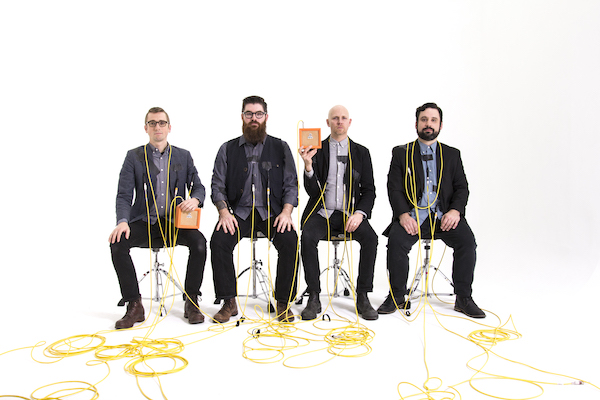Sō Percussion brings out the ritual and reverence of Reich’s “Drumming”

Sō Percussion performed Steve Reich’s “Drumming” Thursday night at the Sanders Theatre. Photo: Monroe Chapman
From the beginning, Steve Reich’s music had the power to mesmerize. With its driving rhythms, slow textural transformations, and communal atmosphere when heard live, his work conveys a sense of ritual and reverence.
Such was the experience Thursday night at Sanders Theatre, where Sō Percussion offered a vigorous performance of Reich’s Drumming as part of the Celebrity Series season.
Drumming is the composer’s longest and most arresting score. Running anywhere between fifty-five and seventy-five minutes–depending on the number of times the individual patterns are repeated–this turbo-charged composition unfolds long-term rhythmic processes to hypnotic effect.
Reich has long been drawn to ideas about sub-tactile pulses as a basic compositional tool. Growing up the forties and fifties, he encountered recordings of Stravinsky’s Rite of Spring, Bach’s Brandenburg Concerto No. 5, and Bebop jazz, and became fascinated by the propulsive thrust and visceral energy that thread this seemingly diverse repertoires together.
Drumming, however, has exotic roots. While studying the musical traditions of Ghana in 1970, Reich was taken with how the criss-crossing drum rhythms stacked upon one another to create new patterns. By then known for his musical experiments, the composer felt that he had discovered an alternative to the post-war European and American avant-garde, with its focus upon extremes of control and freedom. By turning away from the Western tradition, Reich had found a compelling new voice in which to transform it.
Written in 1971, Drumming is organized into four large sections, each marked by subtle shifts in tone color. In the first, percussionists perform on tuned bongos. Syncopated hits interrupt single strokes as the music progresses, and the stuttering rhythms gradually form into a string of relentless churning figures. Reich then employs phase technique, whereby one musician increases the tempo slightly to offset the continuous pulse. The resulting music is at times an amorphous clatter, but as the patterns realign, stunning new metrical shifts emerge, which other musicians echo forcefully on higher-pitched drums.
The second section is scored for marimba and female voices. Here, too, Reich phases the lines in and out of one another, though the music has the added dimension of melody and harmony. The singers perform simple syllables to highlight each new rhythmic cell. But even in light of its short melodic range and thin harmonic layering, Reich’s music maintains an illusion of textural richness.
In part three, the music travels into tessituras that are too high for most singers. Glockenspiel and piccolo carry the music forward without losing intensity. Part four calls for the full ensemble, and the musicians together build the patterns into rousing heights before the music stops abruptly.
Sō Percussion has enjoyed a long association with the work, having recorded it in 2005 on the Cantaloupe label. Their feeling for its spellbinding style and linear structure has only grown deeper since then. Thursday’s performance was epic at nearly 80 minutes, the percussionists hammering out Reich’s ever-changing rhythmic shapes with conviction and a clear sense of the musical form.
The four members of the group—Eric Cha-Beach, Josh Quillen, Adam Sliwinski, and Jason Treuting—were joined by five other percussionists, singers Beth Meyers and Jacqueline Kerrod, and piccolo player Jessica Schmitz. Each percussionist took turns performing the punishing riffs without dropped a beat, moving about the stage to where the different instruments were arranged. Their rhythms coursed and surged, their robust stick techniques yielding wild syncopations and hemiolas.
The performers shaped the phase sections with particularly fine control, each line evolving smoothly for the new patterns to take shape like images in a slow-turning kaleidoscope. Transitions between the larger sections were also seamless. Bongo rhythms flowed effortlessly into the marimba figures, and the glockenspiel passages provided hallow-like effects before dominating the music in part three.
Well-placed microphones and speakers balanced the marimbas, glockenspiels, voices, and piccolo into a bright musical fabric. Singers Meyers and Kerrod delivered their parts with precision. Schmitz played her piccolo with feathery delicacy when called upon, and the percussionists all kept the underlying beats spinning along with vitality.
Even more than in his Four Organs and Music for 18 Musicians, Drumming is an almost spiritual experience for performers and listeners alike, and the audience showered the musicians with rapturous applause.
Enjoyment of Reich’s music didn’t stop there as Cha-Beach, Quillen, Sliwinski, and Treuting offered an animated account of Clapping Music as an encore, proving that even the simplest musical gestures can still be enthralling.
The Celebrity Series will present cellist Gautier Capuçon and pianist Yuja Wang in music by Chopin and Franck 8 p.m. April 6 at Jordan Hall. celebrityseries.org; 617- 482-6661
Posted in Performances




